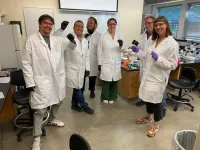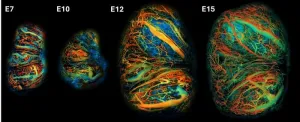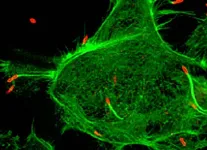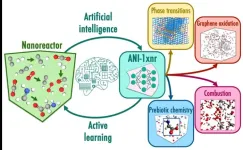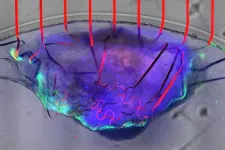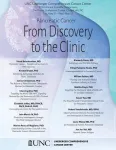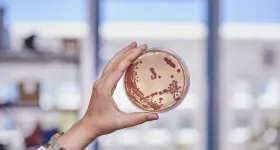(Press-News.org) WOODS HOLE, Mass. –Twelve accomplished science and health journalists have been awarded a highly competitive fellowship in the Logan Science Journalism Program at the Marine Biological Laboratory (MBL).
Now in its 37th year, the Logan Science Journalism Program provides journalists with immersive, hands-on research training, giving them invaluable insight into the practice of science as well as some of the major news stories of today. The program, which offers a Biomedical course and an Environmental course, will run May 13-23 in Woods Hole.
Biographies for the 2024 Logan Science Journalism Fellows are here. They are:
Biomedical Fellows
Pakinam Amer, Independent Writer, Podcaster and Digital Storyteller (Cairo, Egypt)
Lorraine Boissoneault, Producer, Real Science
Karen Brown, Senior Reporter, New England Public Radio
Crystal Chow, Independent Journalist (Hong Kong, S.A.R)
Alok Gupta, Freelance Journalist (Chicago, IL)
Neil Swidey, Editor-at-Large, Boston Globe Magazine
Environmental Fellows
Mark Alpert, Science Journalist and Novelist (New York, NY)
Lindsey Botts, Digital Editor, Sierra Magazine
Jessica Hester, Independent Author and Journalist (Baltimore, MD)
Debra Krol, Indigenous Affairs Reporter, The Arizona Republic
Blythe Terrell, Executive Editor, Science Vs. Podcast
Eva Tesfaye, Coastal Reporter, WWNO (New Orleans Public Radio)
Learning by Doing
In the program’s Biomedical Hands-On Research Course, fellows learn fundamental techniques and approaches that underpin current biomedical science. Guided by senior scientists, they undertake pioneering technologies for imaging and analyzing the human microbiome; genome editing using CRISPR/Cas9; and DNA sequencing and analysis. They will also have ample opportunity to discuss concepts and innovations in biological and biomedical science with the program’s faculty.
In the Environmental Hands-On Research Course, fellows conduct field research at a barrier beach, salt marsh, and watershed ecosystem on Cape Cod. They discover the complex ways that added nitrogen alters coastal ecosystems, including their capacity to keep up with sea-level rise and impacts on marine life and coastal food webs.
All fellows collect, analyze, and interpret research data, which they present at a mini-symposium at the close of the fellowship. They also have opportunities to explore the rich scientific resources in Woods Hole.
The Biomedical Hands-On Research Course is co-directed by Joshua Rosenthal, Ph.D., senior scientist in the MBL’s Bell Center, and Scott Chimileski, Ph.D., research scientist in the MBL’s Bay Paul Center. The course’s journalism advisor is Maryn McKenna, journalist, author and Senior Fellow of the Center for the Study of Human Health at Emory University.
The Environmental Hands-On Research Course is directed by James McClelland, Ph.D., senior scientist in the MBL Ecosystems Center, with faculty Javier Lloret, Ph.D., research scientist in the Ecosystems Center. Science journalist/producer Angela Posada-Swafford is the course’s journalism advisor.
Over the years, the Logan Science Journalism Program has granted fellowships to hundreds of journalists from prominent news organizations, including The New York Times, The Wall Street Journal, Science, National Public Radio, The Washington Post, USA Today, CNN, and Scientific American.
The Logan Science Journalism Program is sponsored by: George & Helen H.B. Logan; Friends and Alumni of the Science Journalism Program; Golden Family Foundation; Howard Hughes Medical Institute; Irving Weinstein Foundation, Inc.; Ross Foundation; and the Byron H. Waksman Fund for Excellence in Science Communication.
—###—
The Marine Biological Laboratory (MBL) is dedicated to scientific discovery – exploring fundamental biology, understanding marine biodiversity and the environment, and informing the human condition through research and education. Founded in Woods Hole, Massachusetts in 1888, the MBL is a private, nonprofit institution and an affiliate of the University of Chicago.
END
DURHAM, N.C. -- Physicians and biomedical engineers at Duke University have developed a method to visualize the growth of a placenta throughout a mouse’s pregnancy. By coupling an implantable window with ultrafast imaging tools, the approach provides the first opportunity to track placental development to better understand how the organ functions during pregnancy.
This new perspective gives researchers a precise way to examine how lifestyle factors like alcohol consumption and health complications like inflammation can affect the placenta and potentially lead to adverse pregnancy outcomes.
The research appears March 20 as the cover ...
The American Meteorological Society continuously publishes research on climate, weather, and water in its 12 journals. Many of these articles are available for early online access–they are peer-reviewed, but not yet in their final published form.
Below is a selection of articles published early online recently. To view full article text, members of the media can contact kpflaumer@ametsoc.org for press login credentials.
Observed Changes in Extreme Precipitation Associated with United States Tropical Cyclones
Journal of Climate
Rainfall ...
URBANA, Ill. – Agricultural occupations are hazardous with one of the highest rates of workplace injuries and fatalities in the U.S. The manual and often strenuous nature of the work, combined with the use of machinery and exposure to environmental hazards create a challenging work environment. Understanding the nature and causes of injuries can help improve safety guidelines and policy measures. However, obtaining a comprehensive overview of injuries is hindered by the absence of a central reporting system. Two ...
In a mouse study, UCLA researchers tested a vaccine against the bacterium that causes melioidosis and found it was highly protective against the disease, which is endemic in many tropical areas, causing approximately 165,000 cases with 89,000 fatalities around the world each year.
The bacterium, called Burkholderia pseudomallei, is spread through contact with contaminated soil and water through inhalation, ingestion or broken skin. It is so dangerous that it is categorized as a Tier 1 Select Agent of bioterrorism, and it can cause ...
The ability to simulate the behavior of systems at the atomic level represents a powerful tool for everything from drug design to materials discovery. A team led by Los Alamos National Laboratory researchers has developed machine learning interatomic potentials that predict molecular energies and forces acting on atoms, enabling simulations that save time and expense compared with existing computational methods.
“Machine learning potentials increasingly offer an effective alternative to computationally ...
AMHERST, Mass. – A team of engineers led by the University of Massachusetts Amherst and including colleagues from the Massachusetts Institute of Technology (MIT) recently announced in the journal Nature Communications that they had successfully built a tissue-like bioelectronic mesh system integrated with an array of atom-thin graphene sensors that can simultaneously measure both the electrical signal and the physical movement of cells in lab-grown human cardiac tissue. In a research first, this tissue-like mesh can grow along with the cardiac cells, ...
The solar energy world is ready for a revolution. Scientists are racing to develop a new type of solar cell using materials that can convert electricity more efficiently than today’s panels.
In a new paper published February 26 in the journal Nature Energy, a University of Colorado Boulder researcher and his international collaborators unveiled an innovative method to manufacture the new solar cells, known as perovskite cells, an achievement critical for the commercialization of what ...
The City University of New York (CUNY) Institute for Implementation Science in Population Health (ISPH) and the CUNY Graduate School of Public Health and Health Policy (CUNY SPH), in collaboration with Pfizer, are initiating a critical two-year prospective epidemiologic study in the spring of 2024 to track acute respiratory infections across the United States.
Project PROTECTS (Prospective Respiratory Outcomes from Tracking and Evaluating Community-based TeSting) builds on the CHASING COVID Cohort Study, which has monitored SARS-CoV-2 infection rates and ...
UNC Lineberger Comprehensive Cancer Center is hosting its 47th annual scientific symposium, “Pancreatic Cancer: From Discovery to the Clinic,” on May 21-22 at the Friday Center for Continuing Education in Chapel Hill, North Carolina.
The symposium is free and will feature 15 talks on the latest in pancreatic cancer basic, translational and clinical research by faculty at the University of North Carolina, Dana-Farber Cancer Institute, Johns Hopkins Sidney Kimmel Cancer Center, Memorial Sloan Kettering Cancer Center, University of Michigan ...
Many important medicines, such as antibiotics and anticancer drugs, are derived from natural products from Bacteria. The enzyme complexes that produce these active ingredients have a modular design that makes them ideal tools for synthetic biology. By exploring protein evolution, a team led by Helge Bode from the Max Planck Institute for Terrestrial Microbiology in Marburg, Germany, has found new "fusion sites" that enable faster and more targeted drug development.
Industry often follows the assembly line principle: components are systematically assembled into complex products, with different production lines yielding different products. However, not humans are the ...
